As a savvy social media marketer, you know that monitoring your social media analytics is crucial — but getting started can be overwhelming.
That’s why we put together the definitive guide, including a handy downloadable template made in Google Sheets and Google Data Studio, to help you know where to start (and where to end up).
We’ll walk you through the data sources and metrics worth paying attention to (and the ones to leave behind), how to use the template to create handy reports, how often to run your reports, and how to tell how your social is really performing.
And since we can’t resist a homegrown use case, we’ll also share how we use social media analysis reporting here at Rival IQ to measure our own performance.
Ready to dive in? Start by accessing our templates here or watch the video below so you can follow along (or go rogue! We won’t mind.):
- Social media analytics dashboard (Looker Studio)
- Social media analytics data input (Google Sheets)

Learn how you can easily build social media analytics dashboards with Rival IQ
See the videoWhat’s a social media analytics dashboard, anyway?
Whether your job is tracking Facebook performance or citywide recycling, you need an easy way to represent that information and how it’s changed over time. Dashboards mean something different to everyone, but for the sake of this social media analytics-focused article, let’s define a dashboard as a visual representation of relevant and up-to-date social media metrics at a glance.
Sometimes it’s easier to define something by what it’s not: A social media analysis dashboard is NOT a laundry list of every social metric you can get your hands on. Editing is really importnant (<–editing joke) when reporting because it can be easy for you or your coworkers to become overwhelmed by too much data.
We’ll get into all the nitty-gritty in a minute, but when creating your own dashboard, you should be able to answer “Hells yes!” to the question, “Does this show how my social media strategy has progressed over time?” Bonus points if you can answer the same to the question, “Can my boss understand it too?”
It’s easy for everyone in marketing (including me!) to get caught up in the doing and forget about the “how’s it doing?” If you need a few reasons to justify stepping back to focus on social media analytics to your boss (or to yourself), here’s why it’s important:
- Demonstrate how your work is benefitting your company over time.
- Understand which channels and content are reaching, growing, and converting your audiences so you can decide where to invest your time, efforts, and budget.
- Accurate info = ability to demonstrate impact = bigger marketing budgets. Social media spending is only going up in the U.S., with the expense expected to surpass $82 billion by 2025. This is where marketing dollars are headed, so keeping an eye on your performance will help you get a bigger piece of that pie.
Since dashboards are all about pulling together the stats you need most, you have two options: You can either hit each social channel’s backend manually, or you can employ some robots to do it for you. We, of course, use our tool to do our own social media analysis, but for those who aren’t yet ready to become Rival IQ customers, we’ll walk through both.
Note: For the sake of simplicity, we’re going to focus this article on the big four — Facebook, Twitter, Instagram, and TikTok — and focus on businesses and pages instead of individuals.
How to locate your social media analytics natively
The good news: Since these channels want to keep you on their platform, they make it pretty easy for you to access your stats and see how your posts are performing.
Facebook houses its analytics in two different places: Facebook Insights and Meta Business Suite. While Facebook Insights focuses exclusively on your Facebook Page’s performance, Meta Business Suite is the “umbrella” platform for managing both Facebook and Instagram.
Both sources report much of the same data, so you can take a look at your analytics in either. You’ll be able to toggle the date range and dive deeper into all sorts of metrics in order to better understand how your posts are faring.
However, if you want to export your Page’s insights data, Meta Business Suite will be the one to go to. Simply head over to the Results tab and press the export option in the top right corner of each metric. This will be how you get your data out of Facebook and into your computational software of choice (like Excel or Google Sheets) so that you can build your dashboard.

For the full rundown of accessing and measuring your Facebook performance, check out our ultimate Facebook analytics guide.
X (formerly Twitter)
Accessing Twitter analytics has gotten a bit more complicated since the platform became X. While all accounts used to have access to their performance data, as of writing, only X Premium subscribers have access to account analytics. Verified Organizations — accounts with the gold checkmarks — can also see their analytics.
Another option that X promotes is to convert your personal account into a Professional Account, which comes with helpful features for promoting your business, including a performance dashboard called Professional Home. Unfortunately, the roll-out of that has been a bit slow so not everyone has access.
The good news? Once you’ve gotten past the gates, so to speak, and secured access to your analytics, the data is available for export in .CSV format.
Instagram really wants you to use it on your mobile device, and requires you to be a business account (instead of an individual account, though verified accounts are an exception) to see any meaningful stats.
Fortunately, once you meet that criteria, you can access a fair amount of information about your activity, content, and audience by tapping the Professional dashboard bar under your profile description or navigating to Settings and activity (the hamburger menu in the top right corner of your profile) and then Insights . Thankfully, Instagram’s Graph API allows third-party tools (like ours) to display your stats in the desktop app or web browser of your choice.

TikTok
Like most other social platforms, TikTok requires you to have a business account in order to see your analytics. Luckily, all you need to do is toggle “on” the Business account option in your settings to get access. Once that’s done, simply navigate to your Business Suite and then click the Analytics tab. It should look a little something like this:

As you can see, you can easily export your insights with a click of the Download data button in the top right corner — a handy feature you’ll need to build your dashboard.
Want more details on how to approach TikTok’s analytics? We go more in-depth in our handy TikTok analytics reporting guide.
Aggregated social media analytics
Okay, we’re biased: We like seeing all our social analytics in one spot. Social media analysis software can make a marketer’s life easier so she doesn’t have to go channel by channel to access her stats. Here’s what we want in a social media analytics app:
- The ability to analyze your stats across multiple channels
- Meaningful insights to help you go beyond the numbers
- Even more stat breakdowns than you can get on native analytics (like follower adds and removes in Instagram, for example)
- Scheduled reports so your favorite social stats are delivered in-app or to your inbox when you need them
- To really take this article to a meta level, custom dashboards are a handy feature too
How do I build my own social media analytics dashboard?
Your (virtual) pencils are sharpened. You’ve found all the data you need in each channel by taking the steps above. You’re fully caffeinated. Now what? Time to turn disparate social media analytics into a colorful and easy-to-read dashboard using Google Sheets and Google Data Studio.
Step 1: Aggregate your data in Google Sheets
Take those semi-scary spreadsheets you downloaded from your channels of choice, and put each of them in separate, named tabs in a Google Sheet. No need to clean up columns you aren’t planning to use. The bottom of your spreadsheet should look something like this:
![]()
Wondering about that cross-channel tab? We pulled that right out of Rival IQ, where we’ve got channel-specific reports along with a handy roll-up of how you’re doing across all your active channels.

Step 2: Connect Google Sheets to Google Data Studio
When you log into Google Data Studio and create a new report, you’ll see something that looks like this:
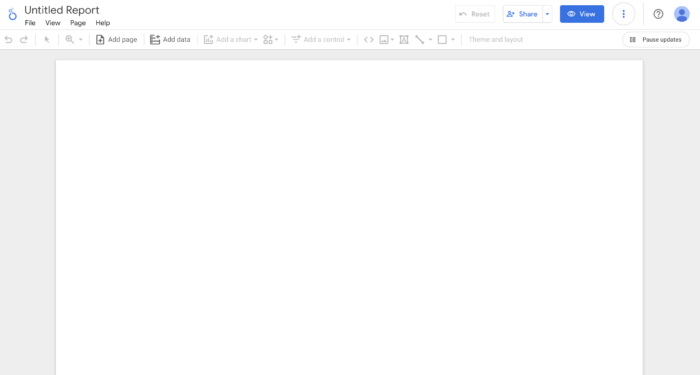
Click on Add data to connect to data or select your own data source.

If you opt to connect to data, you’ll be taken to a page full of GDS connectors, which are external applications that play nicely with GDS (including ours!). Select Google Sheets, and then find the stat-heavy spreadsheet you created in Step 1.

Select the spreadsheet and/or worksheets you want, and then hit the blue Add button. You should end up with the screen below, indicating your data is connected and that your custom dashboard is ready to be designed.
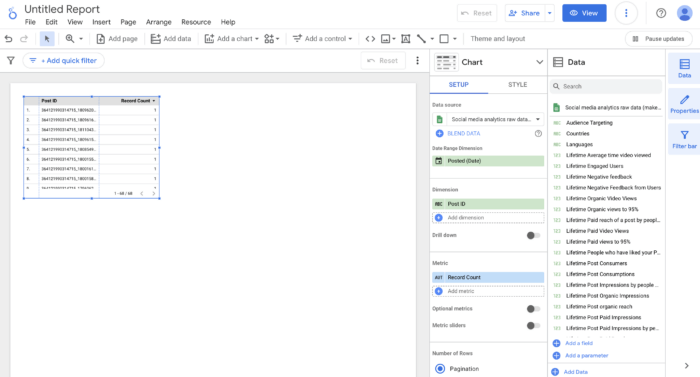
Step 3: Create the custom dashboard of your dreams
We included some sample data on the two pages of our embedded report for reference, but our basic rule of thumb is that as long as your social channel reports on it, you can visualize it. Clicking Add a chart will show you the countless options you have for visualizing your data.

Let’s break down what we featured on our dashboard.

We used scorecards to report on our cross-channel metrics because they’re great at displaying discrete pieces of data and their red (bad) or green (good) changes over time.

We love looking at post engagement by type, so we created the top left blue visualization using the bar graph, with the following setup:

To start, we pointed the data source at the Facebook tab in our spreadsheet. Then, we set our dimension (think “attribute,” like post type) as “type” (for post type) and our metric (think “thing you can count”) as “Lifetime engaged users.” To keep things tidy, we sorted by engagement for descending bars.
This report makes it easy to see that links are our best tool for maximizing engagement on Facebook and that we should absolutely stick with that post type.
To look a little more closely at the type of engagement we were seeing on each post type, we created the colorful bar graph on the right to look at reach versus impressions using the following setup:

By keeping the data source and dimension the same, we were able to really dig into the types of engagement we were seeing on each post. More evidence that our audience thinks we should stick with links.
You can thumb through the rest of the template for other data visualizations, but here are a few other ideas:
- Content engagement: Display your post/tweet content right next to its engagement for clues about the best words, hashtags, and post lengths.
- Engagement by date: Is there a day of the week or month that consistently does well? Map your data using a bar graph or a time series to spot trends.
- Scorecard: Represent key data by channel, like URL clicks and retweets using GDS’ at-a-glance scorecards.
Step 4: Take things from good to great with titles and date ranges
Two quick steps will help your boss figure out exactly what she’s looking at without you having to walk her through it step-by-step.
Since creating a dashboard means combining your best data into one or two pages, titles are your friend. Use them to differentiate your visualizations.
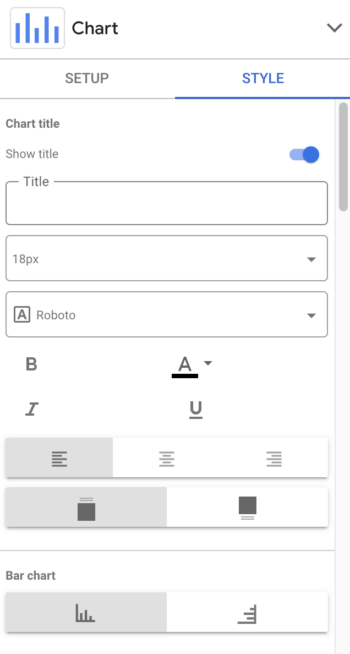
Date ranges pull double-duty by both answering the inevitable “What time period am I looking at?” question and helping you recycle the same dashboard all year long. With an easy-to-toggle date range stretched across the top, you can select different time periods from Google’s drop-down menu, or just pick your own dates to feature.

Want more information on using Google Data Studio? Check out this recording and tons of free resources from a webinar we did with data legend Dana DiTomaso.
The most important metrics to focus on
It can be overwhelming to start reporting on your social from scratch, so we want to help you focus on the metrics that matter and leave behind the ones that don’t. Here are a few of our favorites:
- Clicks
- Conversions
- Engagement
- Reach
We recommend these metrics because they indicate how a customer or fan is interacting with us, our content, and our product. They’re also great since they can be tracked over time, unlike more one-off actions such as likes or follows.
Paid social
If you’re putting money behind your posts, it’s important to look at a few different metrics to see how your investment is faring:
- CPM: Roughly translated to Cost Per Thousand Impressions (but literally stands for Cost Per Mille), this is a great way to see how much you’re spending to get eyes on your posts.
- Cost Per Result: This stat is a little more variable depending on the action you’re trying to get your customers and fans to take.
- ROAS: It stands for Return on Ad Spend. It’s calculated by dividing the revenue your ad spend brought in by its cost (revenue/cost). While it’s similar to social media ROI, ROAS stands out for being ad-centric, allowing you to take a closer look at your ad campaign and figure out what’s working and what’s not.
Whatever metrics you choose to focus on, be sure they help you answer the question: What’s having the biggest effect on my business/brand/nonprofit/agency?
How often should I report?
The answer to this question, of course, depends on the nature of your job. If you’re a one-person shop, your reporting schedule will no doubt be different than if you sit on a 25-person marketing team as their analytics guru. Our high-level recommendation? Report as often as you have the chance to share your findings and inform future strategy decisions.
Does your team report quarterly to the company about marketing activity? We bet you’ve got your quarterly reports locked down. Does your boss ask for high-level stats weekly? Your weekly reporting game must be great by now.
If you’re still working on establishing a reporting rhythm, here’s our breakdown:
Yearly and quarterly: big picture
These reports are all about the big picture. Here are some questions you want to be asking:
- What’s happening on your channels over time, and how are your strategies doing against your yearly or quarterly goals? (You did set goals, right?)
- Did a new strategy change, like investing heavily in Instagram, correspond to a spike in engagement?
- Are you seeing a bunch of growth or engagement on one channel in particular? If yes, you might want to pivot some of your social energy there in the quarter or year ahead.
- Has your social strategy been responsive to new features, such as the new Stickers launched for Instagram Stories?
- Does your engagement change each year with the seasons or current events (like school getting out or the holidays, for example)?
- Are there channels you aren’t very active on where you should focus some energy in the quarter ahead?
- What are your competitors up to, and how can you emulate their success?
This level of reporting is all about the 30,000-foot view, and much like a long flight, it’s good to put some time and brain power into these periodic reports.
Monthly: diving deeper
Monthly reports bridge the gap between the granularity of weekly reports and the strategic review of quarterly or yearly reports. It’s great to keep an eye on the content, channels, and post types that are doing well. Don’t forget to compare completed campaigns against each other and against the goals you set for them.
Monthly reports can also be good for a quick check-in on your social media health: Did you lose a bunch of followers this month? Might be good to dig in deeper if the answer is “yes.”
Weekly and bi-weekly: going granular
Weekly reports are great for tracking short time periods and content bursts. Check out how this week’s posts fared against last week’s, or look at the performance of your newest campaign. This is all about the 30-inch view, and unless your whole job is social analytics, we bet you’re not spending more than 30 minutes collecting this information.
Remember: Don’t just sit on these analytics! Use them to show your boss and team that your strategy is working, and to refine your strategy and content so it resonates strongly with your social media audience.
Competitive benchmarking: How do I know how I’m doing?
Building up a treasure trove of historical social media analytics is great, but without information about what your competitors are up to, you’ll never be able to accurately answer the question, “How do I know how I’m doing?”
Enter benchmarking. Taking a look at how your competition’s social media analytics measure up to your own provides the context you need to see what works well in your airspace. Anyone can have a million Facebook fans or Instagram followers, but you’re only reaching those fans successfully if you’re doing it better than your competitors.

The basic premise of social media benchmarking is identifying key competitors and leaders in your industry and then keeping an eye on their social metrics over time to check against your own stats.
If you’re Pepsi, you’re probably crawling Coke’s social presences on the regular to see how their page likes and key engagement metrics (Likes, shares, comments, etc.) compare to your own performance. The very same goes for smaller or more local competitors.
It’s pretty safe to say we’re obsessed with benchmarking over here, so much so that we make a big, free report every year tracking Facebook, Instagram, Twitter, and TikTok performance across top industries like fashion, food and beverage, media, sports teams, and more. To see how your industry is doing at a glance, read and download the report here.
And to keep things current and interactive, we also have live benchmarks for top industries, including the most popular hashtags, top-performing posts, posting frequency, and more. Use these for a current snapshot of how you measure up to your competitors.
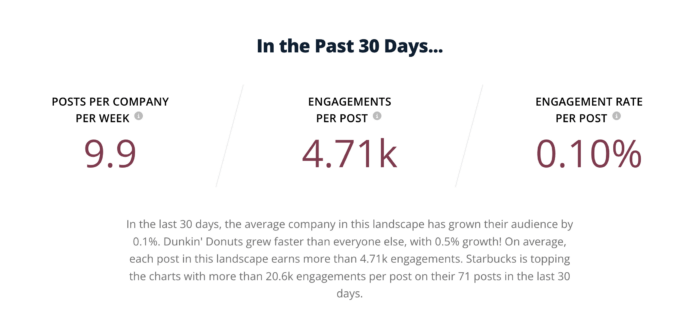
Use case: How do we report on social media analytics at Rival IQ?
Curious how we walk the talk? This group of self-professed data nerds loves reporting on our social media progress. Here are a few ways the company keeps an eye on social success:
Monthly full-team metrics meetings

Our marketing team reports on our social footprint in the prior month to the whole team. (For a full write-up on metrics at Rival IQ and how it relates to pizza, read on here.) We take a close look at our engagement rate by channel month over month and also strive to identify any content, content types, or paid campaigns that we should emulate next time around.
For example, we’ve noticed that our audience seems to love data as much as we do, with our most popular posts often featuring our reports on engagement, so we’re excited to add even more of that into our editorial calendar.
Emailed reports

Let the robots do some of the work for you by having them crawl your social progress and your competition instead of having to do it manually. Automated social media reports from within our app are customizable, so if we want to track a particular campaign or arch nemesis, we can choose how often to get alerts in our inboxes.
Social mentions Slack channel
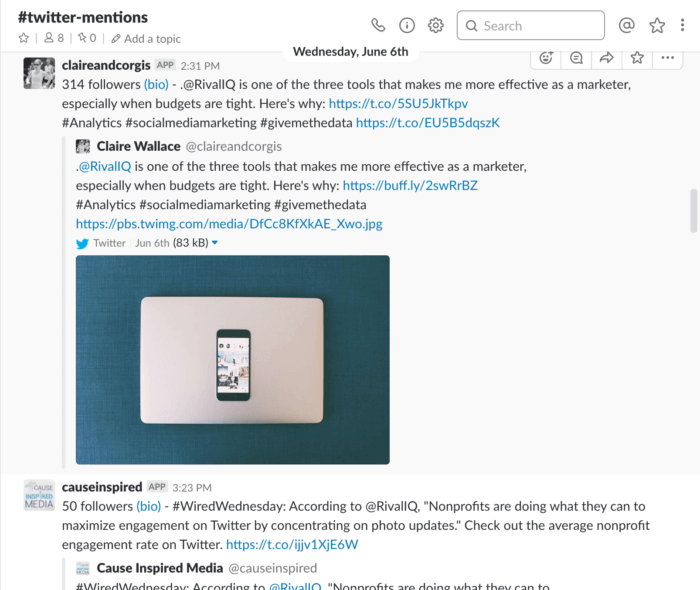
Our resident computer science Ph.D. used automation tool Zapier to cook up a quick Slack channel of all our Twitter mentions, so we can check out who’s chatting about us without leaving the comforts of Slack. Knowing who’s talking about us in real time helps us know who we should be talking to and which content is garnering the most retweets or shares. Want to do this too? Check out the Twitter mentions + Slack integration on Zapier.
Custom social media dashboards in Rival IQ

Sometimes, you just need your social media metrics your way, which is why we offer custom social media dashboards in our app. Put any metric you want from any and every channel into your dashboard for the ultimate bespoke analytics display. We use the view above every single month in our own social media reporting to study our post frequency, engagement rate, and follower count, but the sky’s the limit with these. With hundreds of customizable metrics, this is the best way to report on that one weird Facebook reaction your CEO really cares about or dialing up your cross-channel reporting to 11.
Quick reference guide: social media analytics glossary of terms
Things might get a bit technical, so we’re stashing definitions of some commonly used social media analysis terms here so we’re all on the same page.
Engagement: Measurable interaction on social media posts, including likes, comments, favorites, retweets, shares, and reactions
Engagement rate: Engagement interactions divided by total follower count
Find out what is a good engagement rate on social media. 
Channel: The app you’re using to share your content or connect with your audience (Example: Facebook, Twitter, Instagram, TikTok, Pinterest, Google+, etc.)
Followers: Anyone who’s chosen to like, follow, or otherwise actively opted into your content and activity on a social channel
Audience: Anyone you’re hoping to connect with on social (Note: This isn’t limited to just your followers — thanks to the power of likes, shares, ads, and mysterious algorithms, your content can reach people who don’t follow you directly.)
Post type: The media, often limited by the channel, you can share to engage your followers (For instance, on Facebook, you can share photos, videos, status updates, links, live streams, and more.)
Reach: The total number of people who see your content
Impressions: The number of times your content is displayed
Reporting on this report: How’d we do?
We hope this guide has gotten you excited about reporting on your analytics in a social media dashboard of your very own. We’re firm believers in the idea that you can’t argue with cold, hard data, especially when it’s beautifully presented in a way that anyone can understand.
After all, at the core of effective social strategy is being able to use data to make informed decisions. With the right tools and approach, you can transform raw data into actionable insights that drive your success on social.
Start building your social media analytics dashboard with a free Rival IQ trial. 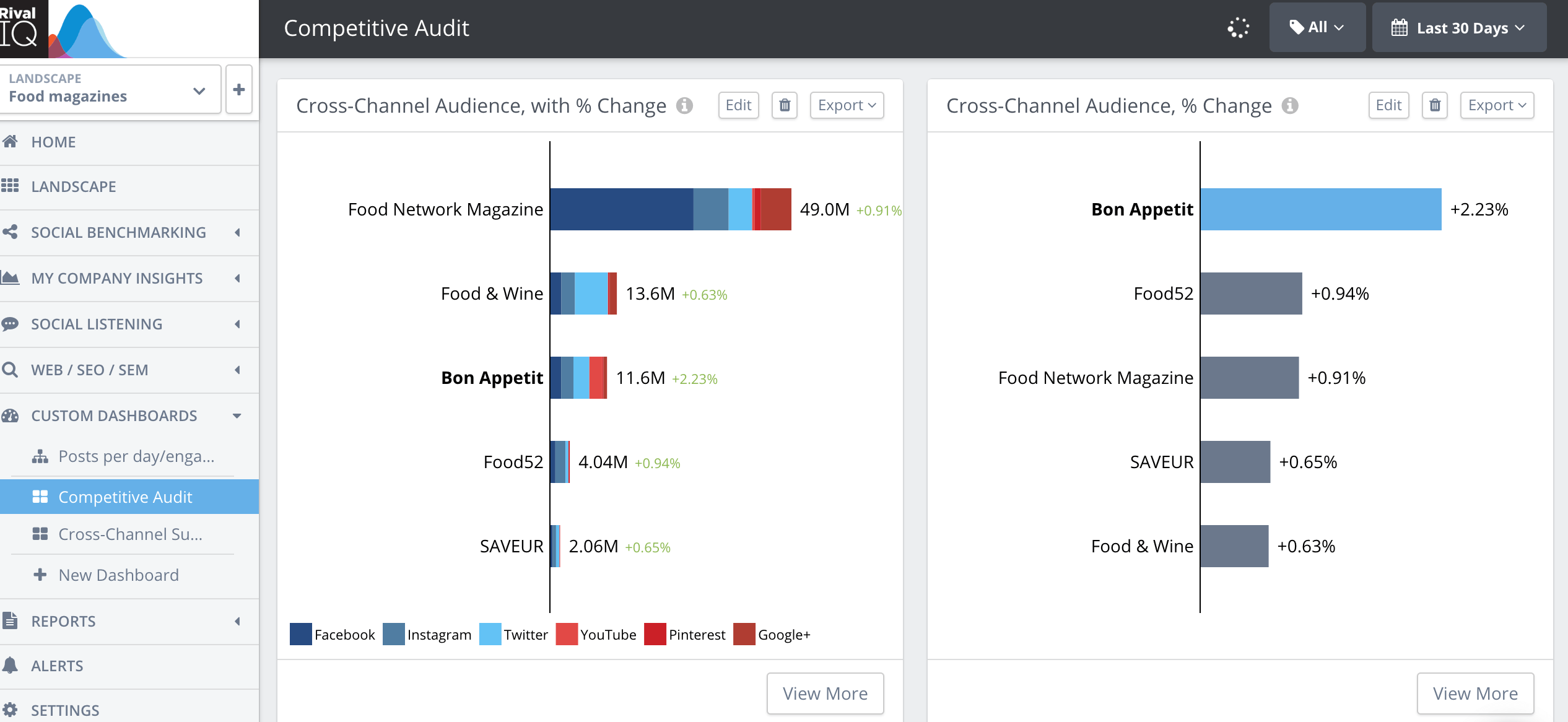
Inspired to create your own social media dashboard in Google Data Studio? Have another way of making your metrics presentable to the masses? We’d love to hear from you on Facebook or Twitter, so don’t hesitate to drop us a line!
This post was originally posted on February 15, 2018, and has since been updated.
